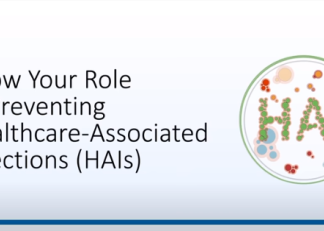Healthcare-Associated Infections
HAIs are germs that can make a person very sick, and thousands of Americans become ill each year from HAIs making them one of the ten leading causes of death in the United States. The most common HAIs are: pneumonia, digestive illness, blood infections, and surgical site infections.
There are important steps that patients and healthcare providers can take to prevent HAIs, like hand washing.
- The HAI program collects, analyzes, and publishes information on the number of HAIs by:
- Healthcare location
- Infection type
- How many healthcare workers get a flu shot every year in New Hampshire.
- HAI Publications provide reports on both HAI and healthcare worker flu shot rates.
Preventing and reducing healthcare-associated infections (HAI) is a top priority for the U.S. Department of Health and Human Services (HHS). The HHS Steering Committee for HAI was established in July 2008, to develop the HHS Action Plan to Prevent Healthcare-Associated Infections, which provides a roadmap for HAI prevention in acute care hospitals. The HHS Action Plan includes recommendations for surveillance, research, communication and metrics for measuring progress towards national goals.
The State HAI Plan to respond and prevent healthcare-associated infections (HAI) is primarily used by the HAI Program and other stakeholders use the plan to identify current progress, guide future initiatives, and identify areas for improvement. The plan can be used as a resource for healthcare facilities and consumers to understand current and planned future HAI prevention and response activities.

ICAR: A Tool to Improve Infection Prevention Processes
ICAR: A Tool to Improve Infection Prevention Processes
The Infection Control Assessment and Response (ICAR) tool is used by members of the Healthcare Associated Infections (HAI) team.
The assessment is non-regulatory, non-punitive and completely voluntary. The information collected in an ICAR may be shared with other state agencies.
The goal is to assist healthcare facilities in determining strengths as well as areas for improvement specific to infection prevention and control policies and practices.
This tool also allows HAI to assist facilities in allocating resources and education, if needed, in order to prevent further outbreaks or gaps in infection prevention practices.
The in-person assessment takes approximately 4 hours to complete.
Ultimately, ICARs help HAI identify areas we can support improved infection control policy and practice at your facility.
Infection Prevention Guidelines
The Centers for Disease Control and Prevention (CDC) and the Healthcare Infection Control Practices Advisory Committee (HICPAC) have published numerous infection prevention guidelines for use in healthcare facilities. The HICPAC is a federal advisory committee made up of 14 external infection control and public health experts who provide guidance to the CDC regarding the practice of:
- Healthcare infection prevention and control
- Strategies for surveillance
- Prevention and control of HAI in United States healthcare facilities.
Additionally, CDC has published infection prevention and control training materials for Project Firstline, specifically for the prevention and management of certain infections in healthcare settings.
Facility HAI Reporting Requirements
New Hampshire statute, (RSA) 151:32-35, requires hospitals, ambulatory surgery centers (ASC), and end-stage renal dialysis centers (ESRD) are to identify, track and report HAI to DHHS.
HAI Annual Reports
New Hampshire law RSA 151 requires some healthcare facilities report specific data to DPHS in order to monitor HAIs.
The law requires reporting of:
- Central line-associated bloodstream infections (CLABSI),
- Central line insertion practices, and,
- Catheter associated urinary tract infections (CAUTI) in intensive care units.
Ambulatory Surgery Centers (ASC) also report data on:
- Surgical site infections following breast, hernia and open reduction fracture procedures.
End Stage Renal Dialysis (Dialysis) Centers are required to report:
- Certain bloodstream and access site infections.
Hospitals also report data on:
- Surgical site infections (SSI) following coronary artery bypass procedures,
- Colon procedures,
- Abdominal hysterectomy procedures, and
- Knee arthroplasty procedures.
The HAI program collects, analyzes and publishes this data annually.
Ambulatory Surgery Centers
- 2022 ASC Annual Report
- 2021 ASC Annual Report
- 2020 ASC Annual Report
- 2019 ASC Annual Report
- 2018 ASC Annual Report
End Stage Renal Dialysis Centers (reports began 2022)
Hospitals
- 2022 Hospital Annual Report
- 2021 Hospital Annual Report
- 2020 Hospital Annual Report
- 2019 Hospital Annual Report
- 2018 Hospital Annual Report
Long-Term Care Centers (reports began 2022)
Healthcare Personnel Influenza Vaccination Coverage
Healthcare personnel can become infected with influenza through contact with infected patients and can transmit influenza to patients and other staff. Because healthcare personnel provide care to patients at high risk for complications of influenza, they should be offered influenza vaccine each year. Monitoring of vaccination coverage in certain New Hampshire healthcare facilities has been required by law since 2008, although the availability of historical data varies by facility type.
Please refer to the annual hospital and ambulatory surgery center reports for facility-specific vaccination coverage data in those settings. The following documents provide information for overall vaccination coverage data in New Hampshire healthcare facilities or facility-specific data in adult day care, supported residential care, and assisted living facilities.
Information for:
The HAI Plan
Four Primary Calls to Action:
- RESPOND to threats of infectious disease transmission
- ANALYZE data to target prevention activities
- PREVENT future HAIs, infection control breaches, high threat infectious diseases (e.g. Ebola) and antimicrobial resistance
- TRAINING and promoting best infection prevention and control practices




